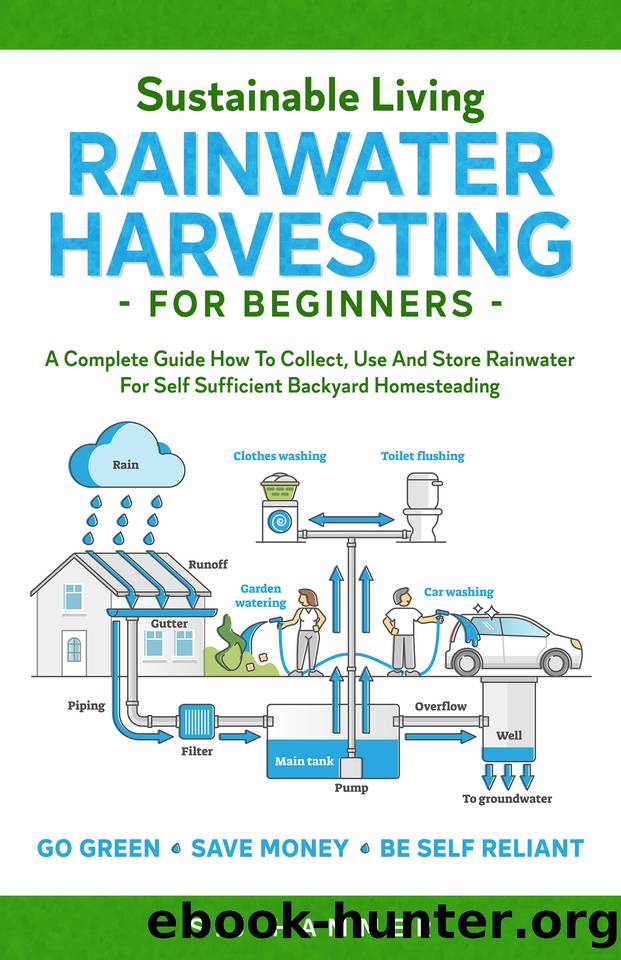Sustainable Living: Rainwater Harvesting For Beginners: A Complete Guide How To Collect, Use And Store Rainwater For Self-Sufficient Backyard Homesteading by Hammer S.J

Author:Hammer, S.J. [Hammer, S.J.]
Language: eng
Format: epub
Published: 2021-09-19T00:00:00+00:00
Rooftop washers are designed to keep debris out of the gutters and away from the infiltration layer. The device should be sized according to the peak flow rate from the roof. Installation can be done on flat or sloped roofs since it hides it in a gutter and works also as a rain screen.
A roof washer looks almost exactly like a debris trap, but its function is different. Roof washers are particularly useful in heavy rains because they prevent leaves from getting wedged into your gutters and blocking the flow of water. A roof washer consists of a flexible pipe that's attached to the end of your plumbing system's downspout and has a flap at the bottom part.
Super Filters
Super filters are another kind of debris removal device. They're specifically designed to collect the most amount of debris possible in the shortest amount of time from your roof's gutters and downspouts while still allowing water to easily flow through them.
Super filters are often made of polyester fiber and can be used indoors or outdoors. They catch both organic and inorganic particles suspended in the water. They incorporate a media filtration system that removes pollutants from the water. The super filter is generally placed downstream of the infiltration layer to protect it from clogging.
Rain Screens
Rain screens (or rain guards) are another kind of debris removal device and often look very similar to fine gutter covers. However, they're much more efficient in preventing a pest infestation and are a lot more cost-efficient as well. Rain screens are formed by a sheet of flexible plastic that forms a neat barrier around the edge of your gutters and roof.
Selecting a Debris Removal Device
It is important to choose a debris removal device that is sized to handle the peak water flow from your roof. When choosing a debris removal device, most will have specific height ranges that they are made to fit in. After you have decided on the height of your roofing system, make sure that the debris removal device has enough clearance above the highest point of your roof.
Therefore, it is best to measure your roof's peak flow at first so that you can determine if your company can handle the higher water flow from your roof or not. Oversized devices are the most ideal because they require less maintenance as they have larger mesh sizes.
Picking a debris removal device that is sized to handle peak water flow from your roof will make sure you have the proper size for your home. The reason behind choosing the largest mesh size of the debris removal device you are looking at is that it will be able to catch more particles per square inch and limit clogging, which results in lower maintenance costs for you and an increase in the longevity of your roofing system.
On the other hand, you may need to think about how often you plan to use the device and the season when most of your rain falls. Oversized devices that require less
Download
This site does not store any files on its server. We only index and link to content provided by other sites. Please contact the content providers to delete copyright contents if any and email us, we'll remove relevant links or contents immediately.
| Acoustics | Bridges |
| Earthwork Design | Environmental |
| Fire Science | Highway & Traffic |
| Hydrology | Remote Sensing |
| Seismic Design | Structural |
| Structural Dynamics | Surveying & Photogrammetry |
| Transportation |
Whiskies Galore by Ian Buxton(41725)
Introduction to Aircraft Design (Cambridge Aerospace Series) by John P. Fielding(33022)
Small Unmanned Fixed-wing Aircraft Design by Andrew J. Keane Andras Sobester James P. Scanlan & András Sóbester & James P. Scanlan(32690)
Craft Beer for the Homebrewer by Michael Agnew(18087)
Turbulence by E. J. Noyes(7901)
The Complete Stick Figure Physics Tutorials by Allen Sarah(7273)
Kaplan MCAT General Chemistry Review by Kaplan(6828)
The Thirst by Nesbo Jo(6769)
Bad Blood by John Carreyrou(6483)
Modelling of Convective Heat and Mass Transfer in Rotating Flows by Igor V. Shevchuk(6359)
Learning SQL by Alan Beaulieu(6166)
Weapons of Math Destruction by Cathy O'Neil(6090)
Man-made Catastrophes and Risk Information Concealment by Dmitry Chernov & Didier Sornette(5883)
Digital Minimalism by Cal Newport;(5593)
Life 3.0: Being Human in the Age of Artificial Intelligence by Tegmark Max(5410)
iGen by Jean M. Twenge(5333)
Secrets of Antigravity Propulsion: Tesla, UFOs, and Classified Aerospace Technology by Ph.D. Paul A. Laviolette(5244)
Design of Trajectory Optimization Approach for Space Maneuver Vehicle Skip Entry Problems by Runqi Chai & Al Savvaris & Antonios Tsourdos & Senchun Chai(4962)
Electronic Devices & Circuits by Jacob Millman & Christos C. Halkias(4871)
